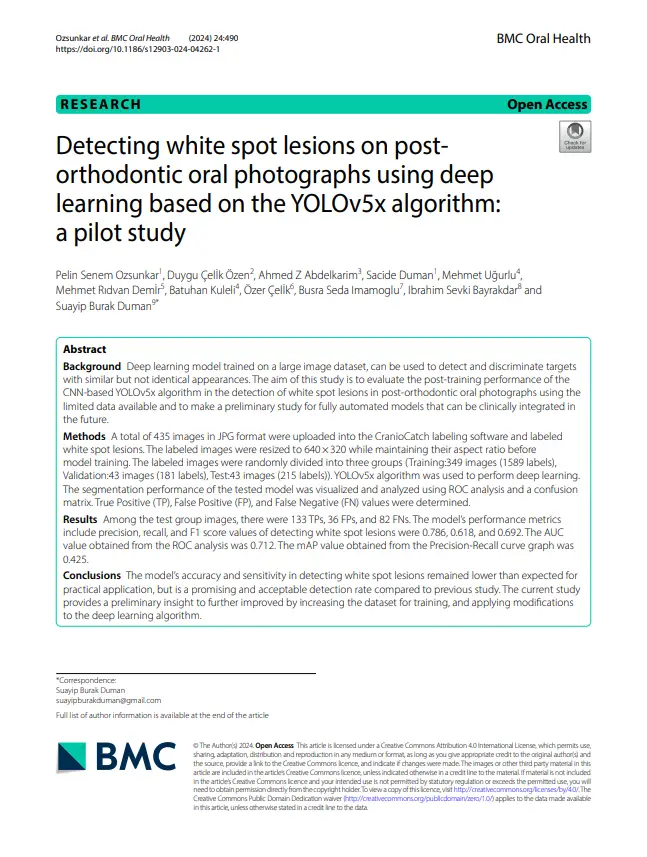Performance of a Convolutional Neural NetworkBased Artificial Intelligence Algorithm for Automatic Cephalometric Landmark Detection
Objective: The study aims to develop an artificial intelligence (AI) model to automatically detect cephalometric landmarks, which are crucial for the diagnosis and treatment of dental and skeletal disorders.
Methods:
- 1620 lateral cephalograms were obtained.
- 21 landmarks were included.
- Labeled data set: 1360 for training, 140 for validation, and 180 for testing.
- Developed a convolutional neural network (CNN)-based AI algorithm.
- Performance evaluated using mean radial error and success detection rate within ranges of 2 mm, 2.5 mm, 3 mm, and 4 mm.
Results:
- AI system (CranioCatch) detected 21 anatomical landmarks.
- Highest success detection rate for the sella point: 98.3% (2 mm), 99.4% (2.5 mm), 99.4% (3 mm), 99.4% (4 mm).
- Mean radial error ± standard deviation for sella point: 0.616 ± 0.43.
- Lowest success detection rate for Gonion point: 48.3% (2 mm), 62.8% (2.5 mm), 73.9% (3 mm), 87.2% (4 mm).
- Mean radial error ± standard deviation for Gonion point: 8.304 ± 2.98.
Conclusion: Although the success of automatic landmark detection was not sufficient for clinical use, AI-based cephalometric analysis systems show promise for improving diagnosis, treatment planning, and follow-up in clinical orthodontics practice.
Introduction: Orthodontics focuses on diagnosing and correcting malocclusions and defects in craniofacial structures. Precise diagnosis and treatment planning are crucial, often relying on cephalometric radiographs, which provide critical information about skeletal relationships and growth patterns. Manual landmark detection on these radiographs is tedious and prone to variability, leading to the development of AI-based automatic detection systems.
Methods:
- Radiographic Images Data Sets: Lateral cephalometric images of patients aged 9-20 years were used. Images with errors or artifacts were excluded.
- Ground Truth Labeling: 21 cephalometric landmarks were annotated using CranioCatch Annotation Software.
- Deep Learning Architecture: The study utilized a feature aggregation and refinement network (FARNet) comprising a backbone network, multi-scale feature aggregation (MSFA), and feature refinement (FR).
- Model Developing: The model was developed using Python and Pytorch library, with training on 1360 images, validation on 140 images, and testing on 180 images.
- Evaluation of Model Performance: Performance was measured using mean radial error (MRE) and standard deviation (SD), along with success detection rates (SDR) for precision ranges of 2 mm, 2.5 mm, 3 mm, and 4 mm.
Results:
- The AI system (CranioCatch) successfully detected 21 anatomical landmarks with varying success rates.
- The highest detection accuracy was achieved for the sella point, while the lowest was for the Gonion point.
- Detailed performance metrics for each landmark were provided, highlighting the variability in detection accuracy.
I Want to Write a Scientific Research Project
CranioCatch is a global leader in dental medical technology that improves oral care in the field of dentistry. With AI-supported clinical, educational, and labeling solutions, we provide significant improvements in the diagnosis and treatment of dental diseases using contemporary approaches in advanced machine learning technology.
CranioCatch serves thousands of patients with dental health issues worldwide every day with its innovative technologies. That’s why we eagerly look forward to meeting our valued dentists who wish to work in the field of 'Scientific Research in Dentistry'.



 Contact Us
Contact Us

